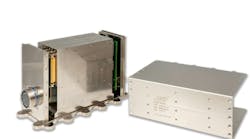John Keller, Editor in Chief
What’s network-centric warfare without the network? Military leaders, unfortunately, may find this out if Congress acquiesces to an anticipated Bush Administration plan to stretch out funding for a U.S. Department of Defense (DOD) advanced satellite-based real-time data communications network.
At issue is the Pentagon’s potential $18 billion Transformational Satellite communications system project, otherwise known as TSAT, which would provide laser communications between the ground and a planned constellation of five orbiting satellites. These spacecraft would use laser cross links among themselves to provide real-time data communications anywhere in the world. The planned system could move Internet-like data as fast as 10 to 40 gigabytes per second.
Put simply, TSAT sits at the top of the DOD’s planned network-centric warfare architecture because it is the spaceborne element of the Global Information Grid (GIG). It is TSAT that will provide the future high-speed network entry point for military users who do not have ground-based connections.
Using high-speed optical communications, Internet Protocol network routing, and communications-on-the-move capability, TSAT will provide a dramatic increase in connectivity, speed, and mobility for future warfighters. Its potential to speed and improve military communications on a worldwide basis is enormous.
The DOD’s concept of network-centric warfare seeks to connect everything from aircraft and warships to individual infantry soldiers on a massive network like the Internet. In fact, TSAT, which has been called the ‘Internet in the sky,’ is perhaps the most vital part of the future global military network.
Think of the military’s future capability if every sensor were on a network, including the foot soldier’s night-vision goggles, infrared rifle sight, and the short-range UAV’s visible-light camera. Now add data to the network from future medical sensors that determine each soldier’s heart rate and body temperature.
With information like this, military commanders in real time could see over the proverbial next hill, keep tabs on enemy positions relatively to friendly forces, and quickly see if their troops in the field were scared, hungry, or overly stressed.
You can imagine a world where the military commanders have this kind of access to sensor-fused information on the battlefield. In theory, this approach has the potential to clear what Clausewitz called the fog of war.
Seen in these terms, the idea of networking everything of military utility makes a lot of sense-provided that the systems are managed right, the experts pay meticulous attention to information security, and the fighting forces have sufficient network bandwidth.
Yet what happens without the most important network in this vision? Can you hear me now? Despite the obvious drawbacks, it is starting to look like the vital TSAT linchpin to network-centric warfare reportedly may be headed for funding trouble in the DOD’s next budget request, which is set to be released for public and congressional review this month.
The Bush administration may be ready to cut the fiscal year 2009 budget for TSAT from about $12 billion to $8 billion. This wouldn’t be out of the ordinary. Spending for TSAT-as it has been for a variety of advanced-technology programs-has been slowed in recent years largely because costs of the wars in Iraq and Afghanistan have taken priority.
These funding reductions, if allowed to happen however, could make up the straw that breaks the camel’s back. Some experts are worried that the TSAT program can withstand no more budget cuts without changing substantially from its original vision. Some reportedly say that the program might not even be able to survive further budget stretchouts.
The TSAT is a different animal where global communications are concerned-primarily because of its planned laser communications links, rather than the SHF and EHF radio frequency links used in other important military satellite communications systems.
Lasers carry tremendous amounts of information and are far less vulnerable to enemy intercepts or jamming than are their slower RF signal cousins.
The capability that TSAT promises does not come without a price. Its development has been complex and difficult, and promises to remain so. Development has not been as quick and smooth as military leaders would have liked, and the continuing military operations in Southwest Asia have drained money from the program’s research work.
The payoffs could be great, however, if the Pentagon and Congress can see their way clear to nurture the program at the financial levels necessary to see it through. Air Force officials point out that a ground-mobile TSAT user, for example, could connect to the network at 1.5 megabits per second (T-1 equivalent) using a one-foot antenna.
Where feasible, the burden is placed on the satellite to allow users to connect at high rates with smaller antennas. This reduction in user antenna size provides battle command with on-the-move capability. Airborne and space-based intelligence, surveillance, and reconnaissance assets also would be supported at high data rates using RF and laser links.
The TSAT team-Lockheed Martin Space Systems and Northrop Grumman Corp.-already have reached a milestone with the program’s laser communications capability, demonstrating the operation of the laser communication brassboard hardware and software at 2.5, 10, and 40 gigabits per second.
Lockheed Martin serves as the prime contractor, while Northrop Grumman is responsible for the communications payload, including laser and radio-frequency communications and on-board processing. The U.S. Air Force is managing the program at the MILSATCOM Systems Wing at the Space and Missile Systems Center at Los Angeles Air Force Base, Calif.
It’s obvious that TSAT will remain expensive to develop, and that experimental failures occasionally will occur. This is how scientists learn about potential problems, compensate for them, and perfect technological designs.
Starving the TSAT program of vital development money in its early stages because of development worries or potential cost overruns down the line is no way to go about this. TSAT will represent a fundamental advancement in worldwide communications and could give rise to tremendous commercial communications advantages.
Developing TSAT will be long, hard, and expensive, yet it’s worth the support of the Pentagon and Congress.


